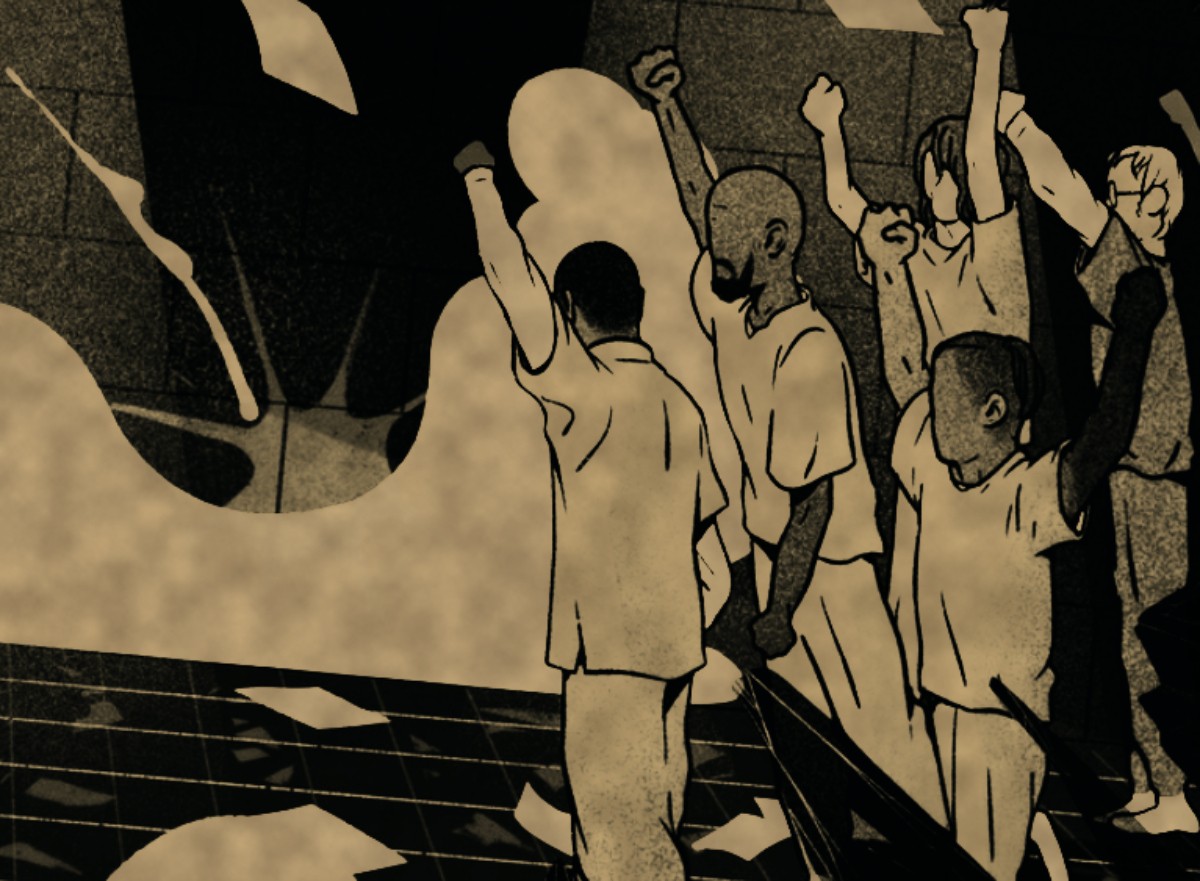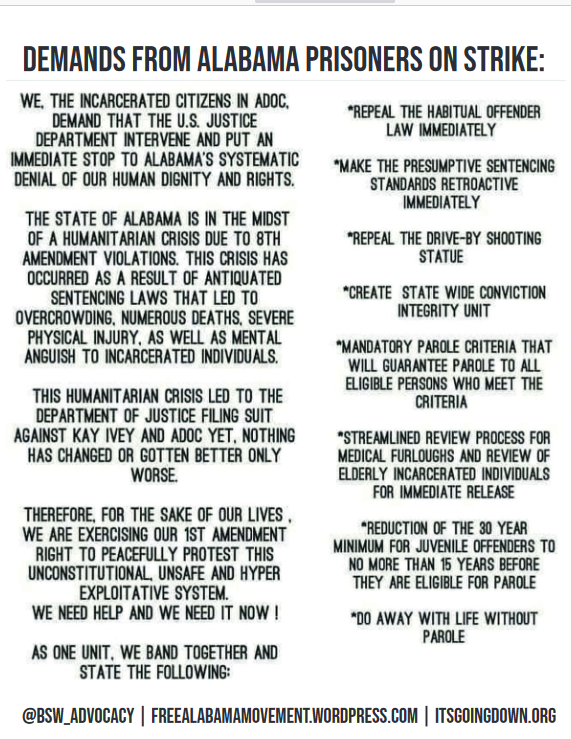Filed under: Featured, Incarceration, Publication, Solidarity, White Supremacy

Announcing a new poster in solidarity with the ongoing Alabama prison strike and a new zine documenting the national prison strike in 2016.
In solidarity with the prisoners on strike across the state of Alabama, here are some simple flyers with the prisoners’ demands that folks can wheatpaste in their towns, as well as a newly compiled zine with accounts and reflections from the 2016 national strike. The zine can hopefully be a useful and accessible resource for folks who mail materials to the inside.
Until Every Cage is Empty,
Blackbird Publishing
Poster in Solidarity with Alabama Prison Strike


Alabama Prison Strike Solidarity Poster PDF – With Demands
Alabama Prison Strike Solidarity Poster PDF – Without Demands
“No Regrets”: Accounts & Reflections from the 2016 National Prison Strike
A Brief Reflection on the Successes and Failures of the 2016 Prison Strike
From No Regrets
The 2016 prison strike took place on September 9th, the 45th anniversary of the Attica Uprising. According to most mainstream media reports, an unprecedented 24,000 prisoners participated, from between 20 to 40 different facilities. The chronology in this text is incomplete, as reports of participation continued to reach the outside weeks and even months later, but it gives a brief idea of the diversity of facilities and tactics that were involved: men’s and women’s facilities; black, white, brown, native; state, federal, and immigration centers—all kinds of people and facilities worked together to make this happen.
Initially called for by the Free Alabama Movement and Free Ohio Movement, two organizations on the inside in their respective states, the organizing for the strike began almost a year prior. I was involved in this process on the outside in North Carolina. For a year or more we coordinated with people on the inside, set up support funds, pushed media outlets into covering the story, and made plans for solidarity actions on the outside. “Let the Crops Rot in the Fields,” an essay and proposal for strike action written by FAM, was a guiding document in our work. Rather than rally at statehouses, or send petitions to politicians—activities that activists had pushed for decades with little success—we centered our agitation and organizing around the prisons themselves, where the self-activity of the prisoners could drive the movement forward.
Groups on the outside like the Incarcerated Workers Organizing Committee (IWOC), as well as dozens if not hundreds of smaller radical publishing groups, books to prisoner programs, affinity groups, Anarchist Black Cross (ABC) chapters, and abolitionist crews formed the foundation of outside strike agitation and solidarity. When September 9th finally arrived, thousands took to the streets, staged noise demos outside prisons, dropped banners, painted graffiti, sabotaged businesses that use prison labor, and organized media campaigns to break through the walls of silence that typically suffocate prisoner-led action. When the dust settled, we spent months organizing phone zaps to discourage guards from retaliating against strike leaders, and raised funds to help prisoners going through periods of punitive segregation.
On the inside, rather than agree nationwide to a single central set of demands, prisoners in their local facilities developed their own messaging and demands based on their own experiences and conditions, as well as their own tactical choices. Some prisoner groups like FAM emphasized non-violence, while others rejected this position in either ideology or practice. Rather than seeking to centralize messaging or tactics, outside organizers encouraged local leadership. Conditions tend to vary wildly from one facility to the next, as do traditions of struggle—this decentralism allowed for people respond most appropriately to their own situation, while still acting in coordinated solidarity with the whole. Despite the year of agitation, and some mainstream media descriptions, most prisoners who participated were not members of formal “political” groups like FAM, FOM, Jailhouse Lawyers Speak, ABC, or IWOC, and thereby had to build their actions from already existent networks of friends or gangs, or simply by spontaneous word of mouth.
In some facilities this resulted in a high degree of ingenuity and creative planning, and in other places prisoners expressed a regret they hadn’t prepared better. Better preparation and forward planning on the inside might also have opened more space and time for outside groups to organize solidarity actions directly with family members of prisoners. From my own perspective, this was also a failure of the 2018 prison strike, which built off the 2016 strike’s momentum but was called for and organized with far less lead-up time than the 2016 action. By contrast, family members seem to be taking a leading role in the current strike under way in Alabama prisons, which is beautiful.
A problem which was raised repeatedly in our correspondence with prisoners in the year leading up to the strike was the fact that only a small percentage of US prisoners actually have “jobs,” properly speaking. Some do work internally in prison workshops, kitchens, or laundries, but in a crisis guards themselves are often able to fill these positions, and only a small percentage perform labor contracted by outside companies. This was a clear obstacle for an action built initially around the idea of labor refusal.
Fortunately, the tactical diversity and organizational decentralism of the 2016 strike allowed it to bypass this limit. Where a traditional refusal to work was neither possible nor relevant, prisoners chose other tactics that equally cost the State money or interfered with the day-to-day management of the facility: peaceful hunger strikes, sit-down protests in yards, the destruction of prison property, and attacks on guards themselves. This strike both expanded and exploded the definition of what a “labor strike” can mean.
This tactical flexibility is a mirror image of the anti-police riots and occupations of the last ten years on the outside. Just as slavery was a major theme in the George Floyd uprising, “prison slavery” was also a central theme in the 2016 strike. In this context, the prison came to be discussed less as a workplace than as a plantation. This language led some to push for constitutional remedies that might address the problem, for example by changing the language around “involuntary servitude” in the 13th amendment. But this was a recuperative dead-end. The logical trajectory here was not to democratize prisons with paperwork, as some might propose for a workplace; it was to empty and dismantle them. Certainly this trajectory was also due in part to the strong element of anarchist abolitionist participation in the strike.
While the strike was initially called as a one-day affair, the broad diversity of tactics and demands meant that in some cases the strike was short-lived, or fizzled completely, but in other places continued to grow and evolve for weeks, with outside supporters having no idea, given the lockdowns and mailroom censorship. This was a somewhat predictable problem, perhaps with no solution: Communication barriers, especially in prison populations with no cell phone access, made it difficult to know who was still on strike, and what kind of solidarity and messaging they still needed. Even had the initial call included a hard end-date, it’s likely that individual facilities would have chosen to expand and continue their action anyway, to the ignorance of many of us on the outside. This problem also made it difficult to utilize the click-bait and image-driven nature of the 24-hour news cycle.
Evaluating the success of such a broad and varied day of action(s) is difficult, and ultimately prisoners themselves must draw their own conclusions. It can be said that in many cases prisoners’ local demands were met, and in other cases retaliation was swift and brutal; probably most common was some combination of the two. As stated publically by prisoners from Jailhouse Lawyers Speak in South Carolina, as well as anecdotally to me by many in North Carolina and Alabama, resistance on the inside has contributed to guard resignations and staff problems, resulting in states’ inability to fill CO positions in the years that followed 2016, and further heightening staff shortages later caused by Covid-19. This is not dissimilar from the difficulties many cities have reported post-2020 in finding personnel for their police departments.
That inability to staff prisons has at times made life worse for prisoners in the short term, but it has also been cited by state governments as the reason for thousands of people being released early from their sentences, including here in NC. It is an indirect line, but a line nonetheless, that starts with prisoners making their facilities ungovernable and ends with them being sent home. I believe this approach, which centers prisoners’ own power and bases its strategy off of broad, structural understandings of prisons, police, racial capitalism, and the state, has borne far more fruit than state-centered strategies that ignore prisoners’ own organizing and instead narrow their focus to elections, legislation, or the wording of the 13th amendment.
Regardless of its successes and failures, the 2016 prison strike was undoubtedly the most concerted and geographically broad assertion of prisoner power and “convict unity” in the last 50 years. It raised the bar forever for what could happen when inside and outside forces coordinate together, and for the most part the collectives, publishing projects, and organizations that organized solidarity on the outside continue to exist and evolve in some form or another. Speaking personally, it was a period of struggle that forever changed me and what I believe anarchists in North America, both in and out of prison, are capable of.
As I type this, prisoners are once again refusing to work across facilities in Alabama. I hope this zine finds its way through the bars so that the courage of 2016 can inspire new waves of self-organization and action on both sides of the walls.
Until Every Cage is Empty,
John






